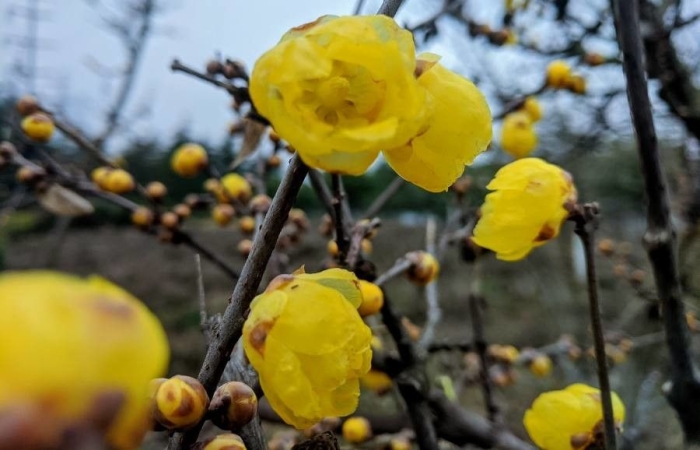Wintersweet
(Chimonanthus praecox)
Wintersweet (Chimonanthus praecox)
/
/

sci nsk
CC BY-SA 4.0
Image By:
sci nsk
Recorded By:
Copyright:
CC BY-SA 4.0
Copyright Notice:
Photo by: sci nsk | License Type: CC BY-SA 4.0 | License URL: https://creativecommons.org/licenses/by-sa/4.0/ | Attribution: sci nsk (cc-by-sa) | Rights Holder: sci nsk | Publisher: PlantNet | Date Created: 2020-01-22T11:42:07Z | Title: Chimonanthus praecox (L.) Link: flower | Notes: |

















Estimated Native Range
Summary
Chimonanthus praecox, commonly known as Wintersweet, is a deciduous shrub native to the forest margins, open woodlands, and scrub areas of North-Central and South-Central China. It typically grows to a height of 10-15 feet and a width of 8-12 feet. Wintersweet is notable for its highly fragrant, waxy flowers that bloom in various shades including yellow, purple, red, white, and brown, primarily during the winter and early spring months when few other plants are in flower. The flowers are considered quite showy and are a significant source of color and fragrance during the dormant season.
Wintersweet is valued for its ability to provide winter interest in gardens, with its sweetly scented flowers that can brighten up the coldest days. It is commonly used in border plantings, as a specimen shrub, and for cut flower arrangements. This plant prefers full sun to part shade and requires medium amounts of water. It is adaptable to a range of soil types, provided they have good drainage. The cultivars Chimonanthus praecox ’Grandiflorus’ and Chimonanthus praecox ’Luteus’ have been awarded the Royal Horticultural Society’s Award of Garden Merit for their exceptional qualities. Gardeners should be aware that Wintersweet can be prone to pests such as scale insects and may suffer from leaf spot diseases. It is also important to prune after flowering to maintain a desirable shape and promote vigorous growth.CC BY-SA 4.0
Wintersweet is valued for its ability to provide winter interest in gardens, with its sweetly scented flowers that can brighten up the coldest days. It is commonly used in border plantings, as a specimen shrub, and for cut flower arrangements. This plant prefers full sun to part shade and requires medium amounts of water. It is adaptable to a range of soil types, provided they have good drainage. The cultivars Chimonanthus praecox ’Grandiflorus’ and Chimonanthus praecox ’Luteus’ have been awarded the Royal Horticultural Society’s Award of Garden Merit for their exceptional qualities. Gardeners should be aware that Wintersweet can be prone to pests such as scale insects and may suffer from leaf spot diseases. It is also important to prune after flowering to maintain a desirable shape and promote vigorous growth.CC BY-SA 4.0
Plant Description
- Plant Type: Shrub
- Height: 10-15 feet
- Width: 8-12 feet
- Growth Rate: Moderate
- Flower Color: Yellow
- Flowering Season: Winter, Spring
- Leaf Retention: Deciduous
Growth Requirements
- Sun: Full Sun, Part Shade
- Water: Medium
- Drainage: Slow, Medium, Fast
Common Uses
Bird Garden, Fragrant, Street Planting
Natural Habitat
Forest margins, open woodlands, and scrub areas in North-Central and South-Central China
Other Names
Common Names: Wintersweet, Japanese-Allspice, Vinterkryddbuske, La Mei
Scientific Names: , Chimonanthus praecox, Chimonanthus fragrans, Calycanthus praecox, Chimonanthus yunnanensis, Chimonanthus praecox var. concolor, Meratia praecox, Chimonanthus praecox var. grandiflorus, Chimonanthus grandiflorus, Chimonanthus praecox var. luteus
GBIF Accepted Name: Chimonanthus praecox (L.) Link